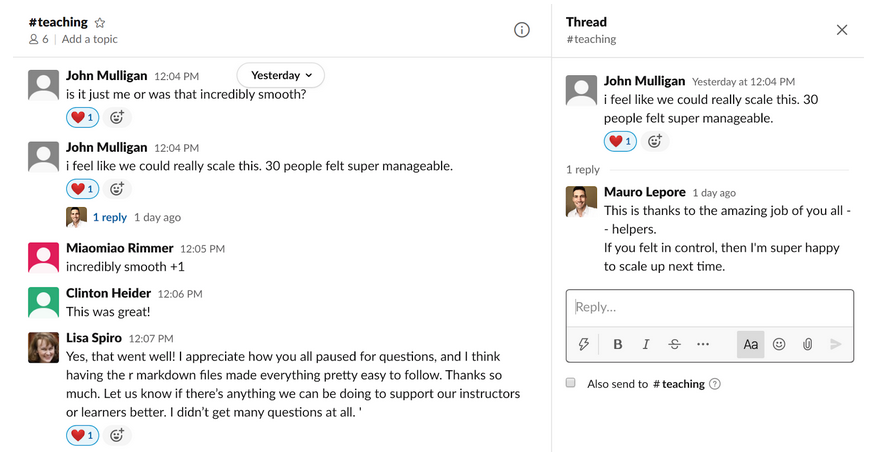Teaching online, smoothly
At 12:04 John Mulligan said “Is it just me or was that incredibly smooth?” We had just finished teaching 30 people online and it felt super manageable. Read on to see what we did and how.

The helpers felt the workshop was incredibly smooth.
What we did
The workshop was based on the materials and philosophy of The Carpentries – a community of volunteers who “teach foundational coding and data science skills to researchers worldwide” . It lasted 6 hours, spread over two days . The teaching staff included two instructors and four helpers. We followed the kind of advice you get from MetaDocencia:
- We met twice to discuss and address our concerns before the workshop.
- We tested the online-meeting platform (Zoom) twice before the workshop.
- We had enough helpers to manage the number of people we committed to teach.
- We used, shared, and enforced a code of conduct.
- We stuck to a simple and predictable schedule: Each block started exactly at the top of the hour, lasted 50’, and was followed by a 10’ break. Despite delays, the structure didn’t change. We allowed lessons to go over to the next block.
- We asked some people to keep their camera on. This kept the speaker engaged and helped them notice when they lost internet connection.
- We had redundant channels for internal communication. We sent most private messages via Slack – Zoom’s chat makes it too easy to accidentally send private messages to everyone.
- We kept learners muted.
- For notes, questions and feedback we used a collaborative document (Google Doc).
- We assumed nothing about the learners:
- We surveyed their experience before the workshop.
- We introduced them to the code of conduct.
- We tested they could all use the features of Zoom we cared about.
- We tested they could all use the collaborative document.
- We showed them how to efficiently manage the limited screen space.
- We explained when we expected them to listen or work on a task.
- We gave them the tools they worked with. (This was a programming workshop, so we gave them the same computing environment we taught from).
Who we are
The learners and helpers were from Rice University. The helpers were mostly graduate students, a few faculty, and one undergraduate student. The helpers were Lisa Spiro, Clinton Heider, Miaomiao Rimmer, and John Mulligan; they were helpful and kind. The instructors were Jackson Hoffart and I; we are data scientists at 2degrees.
How we did it
The learners are the ones who know what works best. Ask them and adjust.
After speaking for 5-10 minutes Jackson or I would ask:
- Take two minutes to do this exercise.
- When you finish, click the “Yes” button on Zoom.
- If you have a question, ask on the Google Doc.
- If you finish early, try the section “Bored?”.
And after each lesson we would ask:
- Please write down your questions and feedback on the google Doc.
- What should we keep doing? And what should we change?
How you adapt to feedback is generally straightforward. If most learners finish early, then you may move faster or make exercises harder. If few learners finish on time, then you may give some hint, explain more slowly, make exercises easier, or answer questions from the Google Doc.
This worked well for the learners. After the workshop they said the workshop was exceptional – that is beyond excellent.

The learners scored the workshop as exceptional ( Net Promoter Score = 70)
And it also worked for the instructors and helpers. We all learned something from each other and from the experience too.

The instructors shared knowledge and learned from the experience.
How about you? What worked for you?